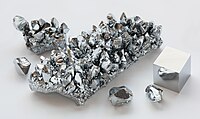
Photo from wikipedia
Transition metal carbides including chromium, molybdenum, and tungsten are of particular interest as renewable energy catalysts due to their low cost and abundance. While several single metal carbide systems form… Click to show full abstract
Transition metal carbides including chromium, molybdenum, and tungsten are of particular interest as renewable energy catalysts due to their low cost and abundance. While several single metal carbide systems form multiple phases with different compositions and crystal structures, most of these materials are not as well studied due to their limited synthetic approaches and instability. By taking advantage of a low temperature salt flux synthetic method, these unique phases can be more easily synthesized and separated as phase pure materials. As an example, Chromium carbide forms five different crystal structures including three common phases, Cr3C2, Cr7C3, and Cr23C6, and two less studied phases, Cr2C and CrC. All five compounds were synthesized using the salt flux method and characterized by X-ray diffraction (XRD), scanning electron microscopy (SEM), X-ray photoelectron spectroscopy (XPS), and electrocatalytic testing for the hydrogen evolution reaction (HER). This low temperature method allows for routine access to multiple compounds in complex phase diagrams and separation of each phase synthetically. This represents a significant step forward in synthesizing rare phases like rocksalt CrC and hexagonal Cr2C and allows for investigation into their potential catalytic properties and future applications.
Journal Title: Dalton transactions
Year Published: 2017
Link to full text (if available)
Share on Social Media: Sign Up to like & get
recommendations!